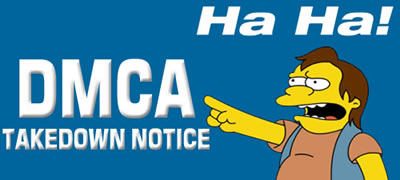What is a DMCA Takedown?
Key Summary: DMCA Takedown can refer to the actual taking down of the content, or to the entire process of initiating a takedown of content that originally belongs to the copyright owner and is used without the copyright owner's permission.
 In order to understand the DMCA Takedown, one must first understand what DMCA is. DMCA stands for Digital Millennium Copyright Act which is an amendment to the Copyright Act of 1976. The purpose of the DMCA is to make the Copyright Act comply with the WIPO Copyright Treaty and the WIPO Performances and Phonograms Treaty, both of which were adopted at the WIPO Diplomatic Conference in December 1996.
In order to understand the DMCA Takedown, one must first understand what DMCA is. DMCA stands for Digital Millennium Copyright Act which is an amendment to the Copyright Act of 1976. The purpose of the DMCA is to make the Copyright Act comply with the WIPO Copyright Treaty and the WIPO Performances and Phonograms Treaty, both of which were adopted at the WIPO Diplomatic Conference in December 1996.
The DMCA aims to protect the rights of content creators to ensure that no one uses their created works without their permission. It added more provisions to the Copyright Act in order to protect the rights of content creators in the digital world. It is increasingly easy to copy content in the digital world, whether that is written content, an image, or something else. It also provides various ways to misuse or misrepresent content. DMCA aims to stop this.
It should be noted that the DMCA and the amended Copyright Act of 1976, are laws in the United States of America. However, there are similar laws present in other countries as well. The objective of all these laws are the same and that is to protect copyrighted content.
It can be very infuriating and discouraging for any creator to find their work on someone else’s site. After all, they are earning from the creator's hard work, or they may be using the work in a manner that the creator did not intend. When this happens, the ideal route is to hire an attorney and file a lawsuit against the person or company. However, this can be very time consuming, and expensive. One can also try to talk to the infringer, i.e. the person who is infringing on their rights, and hope that they will stop and take the content down, or they can also send a cease and desist order, both of which are likely to be ignored.
Here, the DMCA offers some more convenient options to deal with this problem. One can instead submit a Takedown Notice to the webhosting company of the infringing website. A takedown notice or a takedown letter is basically a letter telling the webhosting company that a website hosted on their servers is infringing on other people’s copyrights. However, one must be able to prove that the alleged content belongs to them, which they can easily do by providing a link to the original content.
Once the webhosting company receives the takedown notice, and authenticates the claim, they will then go ahead and send a notice to the infringer to remove the content. If the infringer or offending party does not do so, the webhosting company will remove the content themselves. If the infringer is found to be a repeat offender, i.e. there are multiple notices against them, then most webhosting companies will go ahead and block the infringer's account and website.
Under the DMCA, the webhosting companies are protected from copyright infringement lawsuits only if they take reasonable and swift action to fix copyright infringement as and when they are notified of it. Hence, they must take action to protect the copyrighted content.
DMCA Takedown can refer to the actual taking down of the content, or to the entire process of initiating a takedown. One can issue a takedown notice by thenself, or they can hire a DMCA agent who will handle the entire thing for them.
It should also be noted, that even though the DMCA is part of the Copyright Act, it does not require that content be copyrighted in order to be protected. As long as one can prove that they created the content or that they own the content, if will be protected under DMCA laws. DMCA also protects all types of content, written, photos, videos, etc. Additionally, even if one did not create a photo or a video, but it has them as the subject, and is used without their permission, they can still have it taken down.
|
|
DMCA |
|
Stands for |
Digital Millennium Copyright Act |
|
Full title |
To amend title 17, United States Code, to implement the World Intellectual Property Organization Copyright Treaty and Performances and Phonograms Treaty, and for other purposes |
|
Also known as |
the WIPO Copyright and Performances and Phonograms Treaties Implementation Act |
|
Type of |
Copyright Law |
|
Purpose |
Protects rights of copyrighted works and their authors. |
|
Passed |
October 28, 1998 |
|
Amends |
The Copyright Act of 1976 |
|
Complies with |
the WIPO Copyright Treaty and the WIPO Performances and Phonograms Treaty |
Reference: Wikipedia, DMCA, IPWatchdog, NPPA Image Courtesy: sites.lafayette.edu









Add new comment